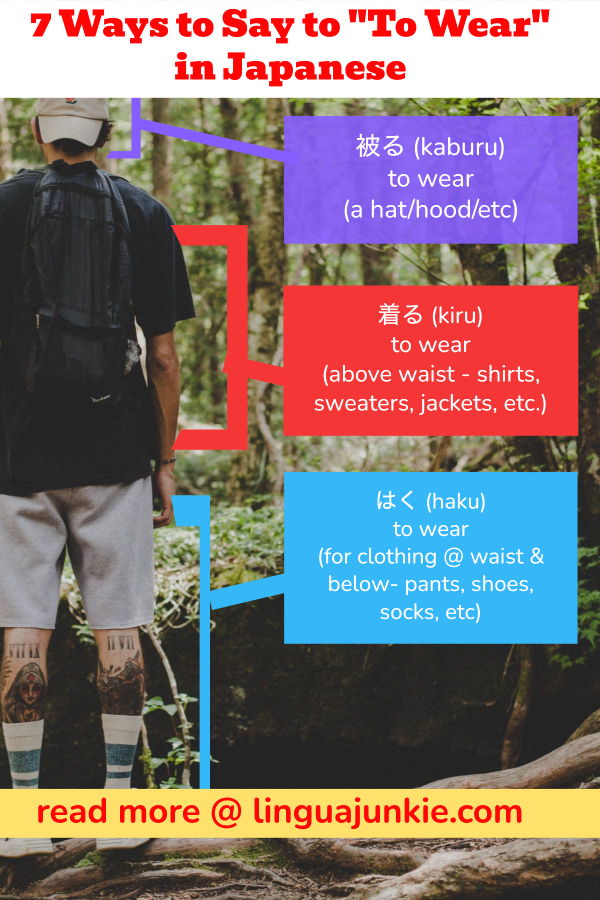How do you say to wear in Japanese?
Good question. 🤔
Glad I asked.
Japanese has many different words for the verb “to wear” or “to put on.” These words are used differently depending on the item of clothing and type of accessories. And in this guide, you’ll learn them all. From how to wear shoes in Japanese… to pants, shirts, cologne, and hats.
Let’s jump in.

 | Want to get Free Japanese Workbooks? Click here to get the workbooks at JapanesePod101. |
1. 着る
- Reading: Kiru
- To wear clothes on the upper body or full body clothes
This is the first way to say to wear in Japanese.
“Kiru” is the verb for wearing clothes that are on your upper body. This can include clothing items like shirts, sweaters, sweatshirts, and more. “Kiru” also applies to clothing that covers your whole body like coats, jackets, or dresses. One exception to these rules is when you say “to wear a bra” which would be “suru” instead of “kiru”.
Examples:
- 洋服を着る。(Youfuku o kiru.)
- I wear clothes.
- 冬のコートを着た方がいいと思う。(Fuyu no kooto o kita houga iito omou.)
- I think I should wear a winter coat.
- シャツを着る。(Shatsu o kiru.)
- I wear a shirt.
- ドレスを着る。(Doresu o kiru.)
- I wear a dress.
2. はく
- Haku
- To put on clothes on the lower body, including shoes and socks.
First there was “kiru.”
Then “haku,” which is the second most common way to say wear in Japanese.
You should use “haku” for lower body clothes. These clothing items can include jeans, pants, shorts, underwear, socks, shoes, and skirts.
So, if you want to know how say to say… to wear shoes in Japanese… yes, it’s “haku.”
Examples:
- ヒールをはく。(Hiiru o haku.)
- I wear heels.
- スーツを着るときは、おしゃれなくつをはく。(Suutsu o kiru toki wa, oshare na kutsu o haku.)
- When I wear a suit, I’ll also wear fashionable shoes.
- 彼は靴下とサンダルとはく。(Kare wa kutsushita to sandaru to haku.)
- He wears socks and sandals.
- 今日はずぼんをはく。(Kyou wa zubon o haku.)
- Today I wear pants.
3. する
- Suru
- To wear accessories and makeup
Wearing accessories is usually described as “suru”.
Accessories can include watches, bracelets, rings, necklaces, earrings, scarves, neckties, and more. It does not typically include hair accessories. In particular, “suru” is the only verb that is used with putting on makeup. Wearing a bra is also used with “suru”.
Oh, and if you want to know how to say to wear a mask in Japanese? Yep, also “suru.”
Examples:
- 今日お化粧をする。(Kyou okeshou o suru.)
- Today I put on makeup.
- 彼女は毎日時計をする。(Kanojo wa mainichi tokei o suru.)
- She wears a watch every day.
- ネックレスをする。(Nekkuresu o suru.)
- I put on a necklace.
- マスクをしてください。 (Masuku wo shite kudasai)
- Please wear a mask.
4. つける
- Tsukeru
- To “attach” accessories, including hair accessories, as well as perfume/cologne.
“Tsukeru” can be used almost synonymously with “suru”.
Watches, necklaces, and any other accessory that was used with “suru” can be used here. However, “Tsukeru” has a connotation that you are sticking something on… or attaching it. This is why it also works well with smaller accessories that are more like embellishments such as hair accessories. Another exception is that makeup cannot be used with “tsukeru”.
But, you can use “tsukeru” if you want to say you’re putting on cologne or perfume in Japanese.
Examples:
- 今日は香水をつける。(Kyou wa kosui wo tsukeru)
- Today, I’ll put on cologne/perfume.
- 髪にリボンをつけると可愛い。(Kami ni ribon o tsukeru to kawaii.)
- It’s cute when you put a ribbon in your hair.
- 今日はコートにブローチをつける。(Kyou wa kooto ni buroochi o tsukeru.)
- Today I put a brooch on my coat.
- パーティーにこのピアスをつけていく。(Paatii ni kono piasu o tsuke te iku.)
- I’ll put on this earring for the party.
5. 被る
- Kaburu
- To put on your head
This is the word to use if you want to know how to say… wear a hat in Japanese.
Head-related items can be worn using “kaburu”. However this needs to cover your whole head for it to be “kaburu”. Hats and hoods would be “kaburu”, but bandanas or headbands wouldn’t work with this verb.
Examples:
- 外が寒いから帽子を被る。(Soto ga samui kara boushi o kaburu.)
- Outside is cold so I wear a beanie.
- 雨が降ってきたからフードを被る。(Ame ga futte kita kara fuudo o kaburu.)
- The rain started so I put on the hood.
- 暑い日は帽子を被った方がいい。(It’s a good idea to wear a hat on a hot day.)
- Atsui hi wa boushi o kabutta hou ga ii.
6. はめる
- Hameru
- To put on accessories that fit tightly like belts, watches or rings.
“Hameru” out of the context of wearing or putting on, means to fit in. The word implies that something fits in a snug way. This is why belts, watches or rings can be “hameru”. However, the more common verb is “suru” or “tsukeru”.
Examples:
- 結婚指輪をはめる。(Kekkon yubiwa o hameru.)
- I put on my wedding ring.
- 時計をはめる。(Tokei o hameru.)
- I put on a watch.
- 指輪をどの指にはめるのがいいかな?(Yubiwa o dono yubi ni hameru no ga ii kana?)
- I wonder what finger I should put the ring on?
7. かける
- Kakeru
- To put on glasses
How about wearing glasses in Japanese?
“Kakeru” is the verb for wearing glasses. It can also mean “to suspend” which is why it makes sense with glasses. Japanese people like to think that the glasses are being suspended by your nose and ears.
Examples:
- メガネをかけた方がいいよ。(Megane o kaketa hou ga iiyo.)
- I think you should wear glasses.
- 昔からメガネをかけています。(Mukashi kara megane o kakete imasu.)
- I have been wearing glasses for a long time.
- 今日メガネをかける。(Kyou megane o kakeru.)
- Today I wear glasses.
Back to You
Now you know how to say to wear in Japanese.
“Kiru” for above the waist. “Haku” for below the waist. “Kaburu” for hats. “Kakeru” for glasses.” And then, “suru” and “tsukeru” are for accessories.
Now, back to you.
Does this answer your confusion about how to say wear in Japanese?
Wait, I know, I know. 95% of you who read this are about to throw your papers up in the air because…
You’re shocked that there are so many ways to say “wear” in Japanese. And you’re already thinking that there’s no way you’re going to remember any of this.
Relax drama king/queen. You won’t remember most of these words, yes, BUT… you’ll get used to these words over time. Language is not about “remembering” but getting “used to” the variations and quirks like this. Just like I automatically know that when it comes to Japanese numbers, 100 is hyaku, 200 is nihyaku, 300 is sanbyaku, 400 is yonhayku, 500 is gohyaku, and 600 is roppyaku. Variations galore, yet I know them. I didn’t memorize that stuff.
It just sticks after practice and time.
So, practice over time.
Leave a comment.
I read them all.
– The Main Junkie
